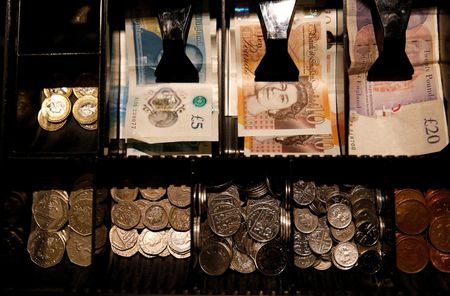By Amanda Cooper
LONDON (Reuters) -Sterling fell on Friday, as investors rushed to safe-haven currencies like the Swiss franc and Japanese yen in light of growing anxiety over the outlook for the U.S. economy, regional banks and global trade tensions.
The pound fell 0.13% to $1.34225, though it was still headed for a weekly rise of 0.7%. Against the Swiss franc, the pound fell 0.5% to 1.0594 francs, its weakest since late 2022.
The dollar came under broad pressure, partly from investors seeking what they perceive to be a safer alternative currency, but also from the expectation that the Federal Reserve will need to cut rates by a percentage point in the coming six months.
A government shutdown has cut off the supply of key data releases, but other metrics are pointing to a slowing labour market and more muted economic activity.
The British economy, meanwhile, just about managed to return to growth in August, offering finance minister Rachel Reeves some relief ahead of her budget that is due in late November.
That said, the International Monetary Fund said this week that Britain’s economy was on course to have the second-fastest growth among the Group of Seven nations in 2025, after the United States, and the Bank of England should be cautious in its approach to rate cuts.
The BOE, which is juggling persistent inflation with meagre economic growth, is not expected to cut rates again until at least February or March.
“With a sparse UK calendar today, sterling’s path will depend on U.S. speaker tones and any Bank of England observations amid looming fiscal budget preparations,” strategists at Monex said.
A slower pace of cuts from the BOE has provided support to sterling, which is up by nearly 7.5% against the dollar this year.
Yet deep-seated concern among investors about the ability of Reeves to keep Britain’s finances on track have tempered gains and weighed on the government bond market this year.
Her November budget is expected to bring with it more tax increases and spending cuts, which in turn may stifle things like consumer spending and business activity.
(Reporting by Amanda Cooper; Editing by Alex Richardson)










